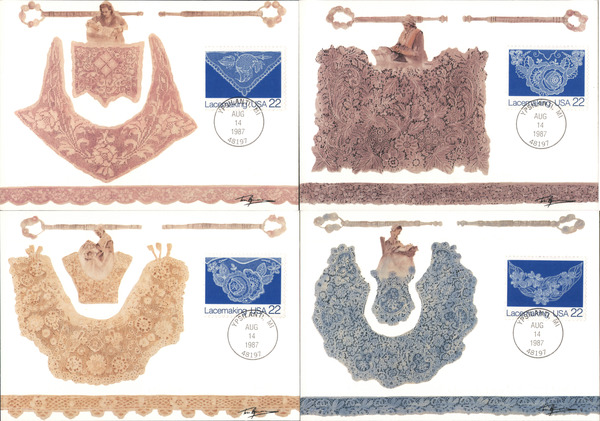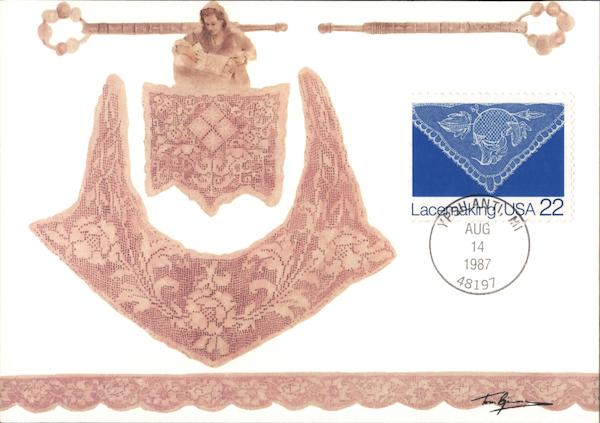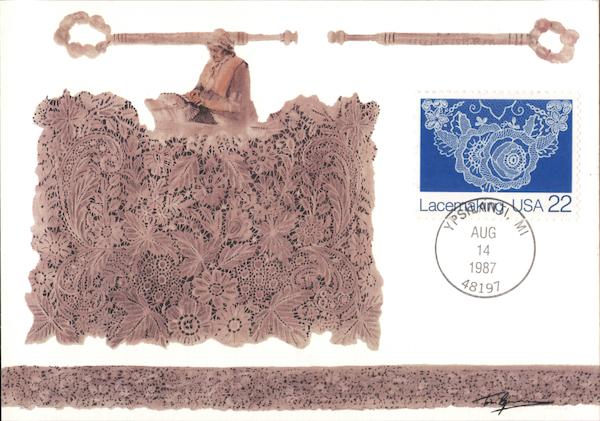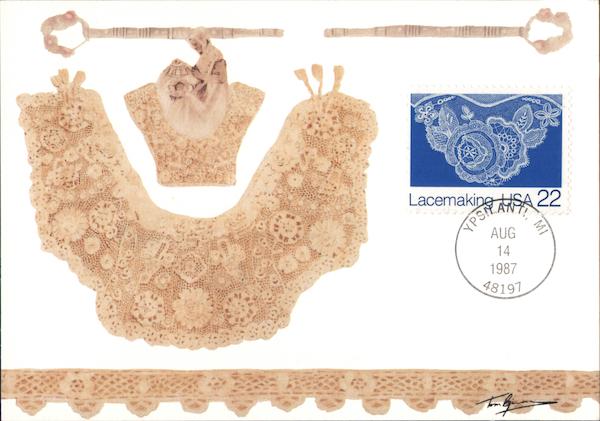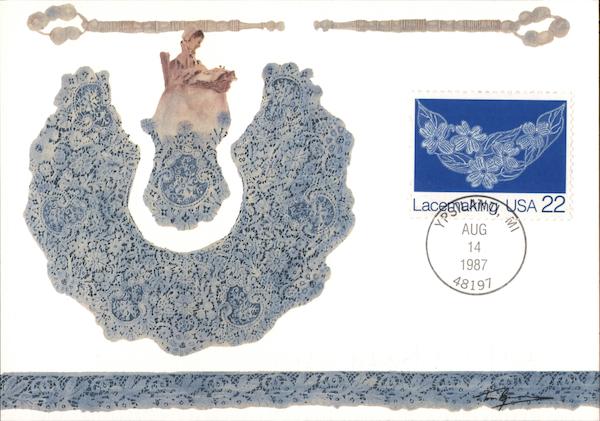Set of 4: 22c Lacemaking
Front:
Lace KNUŞA 22
14
1987
48191
Lacemaking USA 22
14
1987
48191
TATAT
Lace STANA 22
Lacemaking SA 22
14
1987
48191
Lacegnaking USA 22
14
1987
48191
Back:
THE HISTORY OF LACEMAKING
First Day of Issue: August 14, 1987
First Issue Location: Ypsilant, Michigan
The delicate art of lacemaking can trace its origins to
late fifteenth century Italy and Flanders. Used as a de-
corative touch to apparel, lacemaking evolved from
needlepoint work such as the the Italian reticella (little
net) cut work. A type of embroidery, lacemaking is not
made from woven textiles, but rather from patterns
worked in buttonhole stitches also known as punto in
aria (stitch in the air). Lacemaking flourished in the
seventeenth and eighteenth centuries, with several Euro-
pean nations developing one or more characteristic
styles. Point de France, for example, was a low relief
needle lace highlighted by decorative motifs balanced
on a background of hexagonal mesh. In the periods of
its greatest use and popularity — as in the reign of French
King Louis XIV — lacemaking was considered a form of
high art and patterns were drawn by official court pain-
ters. As the “New World" became settled, Europeans —
particularly the English and Spanish — brought lacemak-
ing to America.
No. 87-76
©1987 The Maximum Card Collection
A Division of Unicover Corporation . Cheyenne, WY 82008-0007
Original painting by Tom Bjarnason.
THE ART OF LACEMAKING
First Day of Issue: August 14, 1987
First Issue Location: Ypsilant, Michigan
Skilled hands and nimble fingers are needed to produce
fine lace. Traditional linen lacemaking begins with a
ground mat, called the réseau, which holds the pattern,
also called the toilé, together. Most lace is made with
linen thread, cotton, silk, silver or gold. There are two
traditional types of lace: bobbin and needle point. Bob-
bin lace is sometimes called “pillow lace,” because the
design is drawn on a pillow; then, the lacemaker sticks
small pegs into the pillow and works small bobbins of
threads around the pegs to produce the lace. As the
lacework is finished, the pegs are removed. Needle point
lacemaking uses a brides — a mesh net or groundwork
of connected threads. The lacemaker draws the design
on parchment and stitches it to a linen backing. Lace is
then made by filling in the pattern with buttonhole
stitches. Lacemaking has been a cottage industry in
Europe for centuries. And, with the settlement of the
New World by various nations, individual national and
regional styles and patterns were brought to America.
No. 87-77
1987 The Maximum Card Collection
A Division of Unicover Corporation . Cheyenne, WY 82008-0007
Original painting by Tom Bjarnason.
MODERN LACEMAKING
First Day of Issue: August 14, 1987
First Issue Location: Ypsilant, Michigan
Lacemaking reached its highest artistic achievements
during the Renaissance. Then, it was a mark of prosper-
ity, and it was even glorified in art by such painters as
Raphael, Frans Hals and Velazquez. Female master
lacemakers were in great demand by the courts of
Europe, even until the eighteenth century. At that time,
the English developed a successful lace machine, and
by 1780, the French began using lace net machines as
well. In 1809, Englishman John Heathcoat patented the
first “bobbin net" machine, which John Leavers improved
in 1813. Leavers machine became the basis for all lace
machines used today. Although such machines can ac-
curately copy almost every kind of lace made by hand,
machine-made lace has a flat, dull appearance, can
ravel, and has more irregularities in patterns. Fortunately,
America is still the home of many master lacemakers
whose nimble hands and exquisite design has led a
resurgence in this folk art.
No. 87-78
1987 The Maximum Card Collection
A Division of Unicover Corporation . Cheyenne, WY 82008-0007
Original painting by Tom Bjarnason.
LACEMAKING DESIGNS
First Day of Issue: August 14, 1987
First Issue Location: Ypsilant, Michigan
Lace derives its beauty not only from its delicate,
painstaking handwork, but also from the myriad designs
which take shape under the skillful hands of the
lacemaker. In a piece of lace, the main elements of a
design generally include flower or leaf motifs, but some-
times include human figures, animals, urns, and col-
umns. These are composed of numerous threads stitched
together and often outlined by a cordonnet – a little
cord of several threads whipped or buttonholed together.
Ornamental devices known as modes, or fillings, may
be used between the main elements of the pattern to
replace the fond, or mesh netting. Designs generally
followed contemporary fashions in needle point. Numer-
ous pattern books for various types of openwork fabrics
were published in the sixteenth and early seventeenth
century — the first being those of M. Pagano (c.1542).
Today, American lacemakers have adapted a variety of
styles and techniques in their lacemaking.
No. 87-79
©1987 The Maximum Card Collection
A Division of Unicover Corporation . Cheyenne, WY 82008-0007
Original painting by Tom Bjarnason.

